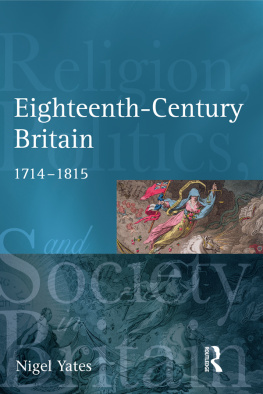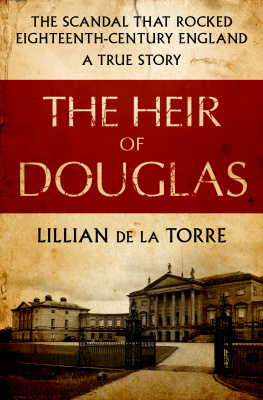Routledge Revivals
THE CHURCH OF ENGLAND IN THE
EIGHTEENTH CENTURY
THE CHURCH OF ENGLAND IN
THE EIGHTEENTH CENTURY
BY
ALFRED PLUMMER, D.D.
FORMERLY MASTER OF UNIVERSITY COLLEGE, DURHAM
AND SOMETIME FELLOW AND TUTOR OF TRINITY COLLEGE, OXFORD
First published in 1910 by Methuen & Co. Ltd.
This edition first published in 2018 by Routledge
2 Park Square, Milton Park, Abingdon, Oxon, OX14 4RN
and by Routledge
711 Third Avenue, New York, NY 10017
Routledge is an imprint of the Taylor & Francis Group, an informa business
1910 Taylor & Francis
All rights reserved. No part of this book may be reprinted or reproduced or utilised in any form or by any electronic, mechanical, or other means, now known or hereafter invented, including photocopying and recording, or in any information storage or retrieval system, without permission in writing from the publishers.
Publishers Note
The publisher has gone to great lengths to ensure the quality of this reprint but points out that some imperfections in the original copies may be apparent.
Disclaimer
The publisher has made every effort to trace copyright holders and welcomes correspondence from those they have been unable to contact.
A Library of Congress record exists under ISBN
ISBN 13: 978-1-138-55693-5 (hbk)
ISBN 13: 978-0-203-70579-7 (ebk)
HANDBOOKS OF ENGLISH CHURCH HISTORY
General Editor:
JOHN HENRY BURN, B.D., F.R.S.E.
EXAMINING CHAPLAIN TO THE BISHOP OF ABERDEEN
THE CHURCH OF ENGLAND IN THE
EIGHTEENTH CENTURY
HANDBOOKS OF
ENGLISH CHURCH HISTORY
______________
I. THE FOUNDATIONS OF THE ENGLISH CHURCH (to A.D. 800). By J. H. MAUDE, M.A.
II. THE SAXON CHURCH AND THE NORMAN CONQUEST (A.D. 8001135). By C. T. CRUTTWELL, M.A.
III. THE MEDIEVAL CHURCH AND THE PAPACY (A.D. 11351485). By A. C. JENNINGS, M.A.
IV. THE REFORMATION PERIOD (A.D. 14851603). By HENRY GEE, D.D.
V. THE STRUGGLE WITH PURITANISM (A.D. 16031702). By BRUCE BLAXLAND, M.A.
VI. THE ENGLISH CHURCH IN THE EIGHTEENTH CENTURY. By ALFRED PLUMMER, D.D.
THE CHURCH OF ENGLAND IN
THE EIGHTEENTH CENTURY
BY
ALFRED PLUMMER, D.D.
FORMERLY MASTER OF UNIVERSITY COLLEGE, DURHAM
AND SOMETIME FELLOW AND TUTOR OF TRINITY COLLEGE, OXFORD
METHUEN & CO.
36 ESSEX STREET W.C.
LONDON
First Published in 1910
T HE initial impulse to undertake the task of editing this series was given me, so far back as 1897, by the late Dr Mandell Creighton, Bishop of London. He was good enough to suggest the names of some of the writers whom I should invite to collaborate; and he drew up what he called a rough scheme, of which the following is a modification.
I. The Foundations of the English Church (to A.D. 800).
II. The Anglo-Saxon Church and the Norman Conquest (A.D. 8001135).
III. The Mediaeval Church and the Papacy (A.D. 11351485).
IV. The Reformation Period (A.D. 14851603).
V. The Struggle with Puritanism (A.D. 16031702).
VI. The English Church in the Eighteenth Century.
The names of the six scholars, who have accepted the invitation to contribute to this series, are a sufficient guarantee that the work is conceived in no narrow spirit of partisanship, but with the earnest desire to do justice to all parties, whether religious or political. The Editor has thought it right to allow to each writer the utmost freedom of treatment consistent with the general plan of the series. If here and there this has resulted in some slight divergence of view between one volume and another, he believes that it will prove rather advantageous than detrimental to the utility of the work; for much would be lost, and very little gained, by preventing a writer from giving free expression to his own view of the facts, and of the inferences to be drawn from them.
J. H. BURN
THE PARSONAGE
BALLATER
I N a period of which so much is known, and of which the materials for additional knowledge are so abundant, as is the case with the eighteenth century, the writer of a handbook sees from the first that a very great deal, of even important matters, will have to be omitted: and one of his chief difficulties will be to decide which topics must be selected in order to give the reader an intelligible and coherent picturefaithful, as far as it goesof the period as a whole. In such circumstances, no two persons judgments will always agree as to what should be sacrificed, and what ought, however concisely, to be preserved. It is, therefore, inevitable that some readers will think that, in the present volume, some features of the age have been retained which might well have given place to others that are passed over in silence. It is hoped that such readers will believe that, at any rate, nothing worse than an error of judgment has been committed. The topics presented to the reader have been selected with a view to giving a correct impression of the leading characteristics of the century. They have not been selected in order to give a particular impression, favourable or unfavourable, of this or that religious body, or of this or that leader. And it has been thought better not to load the pages with details, which, however interesting, might blur rather than deepen, the general effect.
There is room also for difference of opinion as to the way in which the century ought to be subdivided. It is believed that the points of division which have been adopted are intelligible and tenable; for the years 1717, 1737, 1760,1787 are distinguished by events of sufficient importance to justify a division of some kind, and they mark off periods which are fairly equal in length. It is in the three central periods, each of which runs to twenty or more years, that the special characteristics of the century are most abundantly found.
The notes show the writers obligations to many who have written upon this period during the last fifty or sixty years. They also show that original authorities have not been neglected. It is from the latter that the student of the eighteenth century will derive the most abundant instruction and delight.
DULANY, BIDEFORD
CHRISTMAS, 1909
CONTENTS
___________________
THE CHURCH OF ENGLAND IN THE
EIGHTEENTH CENTURY
THE CHURCH OF ENGLAND
IN THE
EIGHTEENTH CENTURY
T HE writer on this period of English History is confronted with two great difficulties: (1) the vast amount of material that is available as evidence and comment; and (2) the apparently contradictory character of the evidence as to the goodness or badness of the age which he has to study.
(1) It is quite true, as regards the first part of the century, that brilliant as is the literature of the age of Queen Anne, there is hardly anything of the first rank that can be placed under the head of contemporary history. When one has mentioned Swift and Bolingbroke, one has named the only two authors of really great talent who attempted to write the history of their own times; and neither of these two has done so with anything like completeness. Nevertheless, even for this part of the period there are smaller writers, of whom perhaps the best is the continuator (? Tindal) of Rapins









